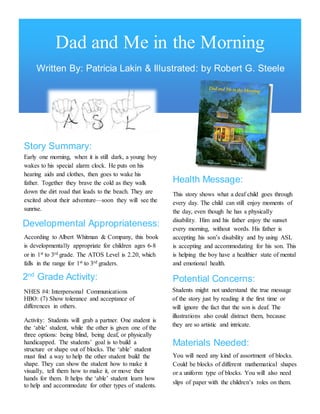Report
Share

Recommended
Recommended
More Related Content
Similar to childs lit project
Similar to childs lit project (20)
Covington ElementaryAshley CovingtonProfessor Lori Infants.docx

Covington ElementaryAshley CovingtonProfessor Lori Infants.docx
Anti-Bullying Week 2014: Lesson activities – guidance notes Key stage 2

Anti-Bullying Week 2014: Lesson activities – guidance notes Key stage 2
605Good Curriculum as a Basis for Differentiation.docx

605Good Curriculum as a Basis for Differentiation.docx
· Chapter 8 Chapter 8 The Preschool YearsThe preschool years 

· Chapter 8 Chapter 8 The Preschool YearsThe preschool years
More from Jessica Mills
More from Jessica Mills (10)
childs lit project
- 1. Dad and Me in the Morning Written By: Patricia Lakin & Illustrated: by Robert G. Steele Story Summary: Early one morning, when it is still dark, a young boy wakes to his special alarm clock. He puts on his hearing aids and clothes, then goes to wake his father. Together they brave the cold as they walk down the dirt road that leads to the beach. They are excited about their adventure—soon they will see the sunrise. According to Albert Whitman & Company, this book is developmentally appropriate for children ages 6-8 or in 1st to 3rd grade. The ATOS Level is 2.20, which falls in the range for 1st to 3rd graders. NHES #4: Interpersonal Communications HBO: (7) Show tolerance and acceptance of differences in others. Activity: Students will grab a partner. One student is the ‘able’ student, while the other is given one of the three options: being blind, being deaf, or physically handicapped. The students’ goal is to build a structure or shape out of blocks. The ‘able’ student must find a way to help the other student build the shape. They can show the student how to make it visually, tell them how to make it, or move their hands for them. It helps the ‘able’ student learn how to help and accommodate for other types of students. Developmental Appropriateness: Health Message: This story shows what a deaf child goes through every day. The child can still enjoy moments of the day, even though he has a physically disability. Him and his father enjoy the sunset every morning, without words. His father is accepting his son’s disability and by using ASL is accepting and accommodating for his son. This is helping the boy have a healthier state of mental and emotional health. Potential Concerns: Students might not understand the true message of the story just by reading it the first time or will ignore the fact that the son is deaf. The illustrations also could distract them, because they are so artistic and intricate. 2nd Grade Activity: Materials Needed: You will need any kind of assortment of blocks. Could be blocks of different mathematical shapes or a uniform type of blocks. You will also need slips of paper with the children’s roles on them.
- 2. 2 Teamwork and Communications Worksheet Directions: One student is the ‘able’ student, while the other is given one of these three options: being blind, being deaf, or physically handicapped. The students’ goal is to build a structure or shape out of blocks. The ‘able’ student must find a way to help the other student build the shape. The ‘able’ student can show the other student how to make it visually (for a deaf student), tell them how to make it (for a blind student), or move their hands for them (for all three options). The only rule is the other student must be the one to build the shape, not the ‘able’ student. Once the shape is made, switch roles and repeat the process.After each student builds the shape, please answer the following discussionquestions. Shape: Duck swimming in the water Discussion Questions: 1. How did it feel to not be the ‘able’ student? 2. How did it feel to be the student who was blind, deaf, or physically handicapped? 3. How were you able to communicate to your partner? Were you successful? 4. After doing this activity, if you were to meet an actual student with one of these disabilities, how would you work with them in a group?